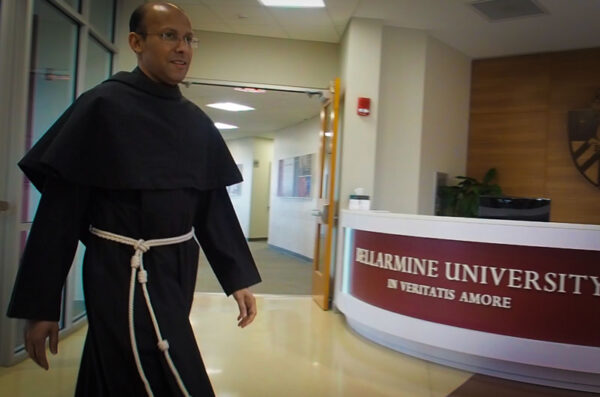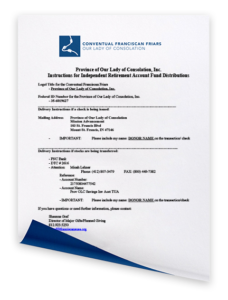Thank you for considering a gift from your Retirement Account or Donor Advised Fund to the Conventual Franciscan Friars of the Province of Our Lady of Consolation.
A gift from your IRA can help the friars and lower your tax bill
- Give from your required distribution directly to the friars and effectively lower your adjusted gross income
- Designate all or a portion of your required distribution to the Friars.
- You do not pay income taxes for the amount of your distributed donation
- If you are at least 72 the amount gifted is tax free and counts towards the minimum distribution requirement (up $100,000 per year)
An IRA Rollover, also called a Qualified Charitable Distribution, is easy to complete. You direct your IRA custodian to issue a gift to the friars directly from your Retirement Account. If you take your distribution from a traditional IRA and put it into your checking account, the distribution incurs taxes since you didn’t pay taxes on the money when you put it into the IRA. But a gift from your IRA to the friars is not income to you.
Name the Friars as a Beneficiary of Your Retirement Account
You can name the friars a beneficiary of your retirement account. If you have an IRA, 401(k), 403(b), or other defined-contribution plan, you can name the friars as a beneficiary of all or a portion of funds remaining upon your death. The amount given to the friars will be subject neither to income nor estate tax. The legal name of the friars is, The Province of Our Lady of Consolation, Inc.
The Friars are qualified to receive a gift from your Donor Advised Fund (DAF)
A donor-advised fund (DAF) is a private fund administered by a third party and created by you for the purpose of making multiple charitable donations. You request a distribution through your DAF account to the friars.
This material has been prepared for informational purposes only, and is not intended to provide, and should not be relied on for, tax, legal or accounting advice.
We Love to Help
Need help? Contact us at (812) 923-5250,
or it is easy as pushing a button.
IRA Rollover Gift to the Friars
Fields marked with an * are required
A friendly Mission Advancement representative will contact you, if you fill out the form below it will help us get back you.
How much should I withdraw this year?
Sometimes only taking the minimum IRA distribution can be a costly mistake. When deciding how much to withdraw this year, you need to consider the big picture. For some people, it makes sense to go big.
Should You Take an Extra Big RMD This Year?
Sometimes only taking the minimum IRA distribution can be a costly mistake. When deciding how much to withdraw this year, you need to consider the big picture. For some people, it makes sense to go big.
 As most IRA investors know, once one reaches age 72, IRS rules require them to take a certain minimum amount from their IRA each year. Many investors do just that — take the minimum — thinking that strategy leaves more assets to grow tax-deferred. But tax changes in recent years are a reason to revisit one’s IRA distribution strategy.
As most IRA investors know, once one reaches age 72, IRS rules require them to take a certain minimum amount from their IRA each year. Many investors do just that — take the minimum — thinking that strategy leaves more assets to grow tax-deferred. But tax changes in recent years are a reason to revisit one’s IRA distribution strategy.
While some folks concerned about paying more in taxes this year than they need to may want to stick to the bare minimum of their required minimum distribution (please see A Simple RMD Mistake That Can Cost Retirees Thousands), others looking at a broader tax strategy might want to consider going big with their RMDs. Let’s look at a couple of examples that illustrate the wisdom of taking more than the required minimum distribution from your IRA.
A Couple Has a Chance to ‘Fill Up’ Their Tax Bracket
Sam and Renee Smith are ages 75 & 71. Sam has an IRA worth $850,000. Their income consists of dividends of $8,000, a pension of $34,000 and a combined Social Security of $77,000. Bob’s 2021 IRA RMD is $37,118. Using the standard deduction of $28,100 (for a married couple where both people are over the age of 65, plus the $300 charitable contribution deduction), we project taxable income of $116,468, which equals $16,560 federal tax. However, the Smiths could recognize another $64,000 of ordinary income from his IRA before their income goes into the 24% tax bracket. In 2022 Renee will have to start taking RMDs on her IRA (current value $1.5 million), which would likely bump the Smiths into the 24% tax bracket.
In this case, we’d recommend Sam Smith take another $64,000 distribution from his IRA this year, filling up the 22% ordinary income tax bracket. Taking the additional distribution from Sam’s IRA should also help reduce his RMD for 2022.
A Man Keeps His High-Earning Beneficiary in Mind
Bill Jones is age 81 and remarried 10 years ago after his first wife passed away. He has an IRA worth $1.3 million and has named his daughter as beneficiary of his IRA. His IRA RMD for this year is $66,000, and he intends to use about $30,000 for qualified charitable distributions (QCDs).
Based on a projection of his 2021 tax return, Bill can take another $22,000 from his IRA, and that income will be taxed at just 12%. Bill’s daughter is age 51 with high earned income and significant assets. We’d advise Bill to “fill up” his 12% marginal ordinary income bracket, as it is likely his daughter will be taxed at a greater rate when she is required to take her beneficiary distributions.
4 Considerations to Help with Your Own RMD Decision
Key considerations for deciding whether you should take more than the IRA RMD in any year:
- Your tax bracket. How much additional income can you recognize this year while still staying within your current tax bracket? Taxpayers in the 10% & 12% tax brackets should be especially mindful of maximizing ordinary income in these relatively low tax brackets.
- Your income. What is your income projected to be next year? Will you (or your spouse) have other sources of income in future years, such as an inherited IRA, spouse’s IRA RMD or annuity income, that should be considered?
- Your beneficiaries. How does your current tax rate compare with the tax rates of your IRA beneficiaries? If you have a large IRA and children with high incomes of their own, your heirs could be forced into a much higher tax bracket when they commence inherited IRA distributions.
- Your Medicare premiums. Increases in income can mean higher Medicare Part B & D premiums in coming years, so that should be considered in the context of total savings.
Taking more than the minimum IRA distribution, while counterintuitive, often yields a more favorable long-term result. Be sure to consult with a tax professional for guidance to navigate your specific situation.
About the Author
Mike Palmer, CFP
Managing Principal, Ark Royal Wealth Management
Mike Palmer has over 25 years of experience helping successful people make smart decisions about money. He is a graduate of the University of North Carolina at Chapel Hill and is a CERTIFIED FINANCIAL PLANNER™ professional. Mr. Palmer is a member of several professional organizations, including the National Association of Personal Financial Advisors (NAPFA) and past member of the TIAA-CREF Board of Advisors.
A Real World Example…
Janet Able has always enjoyed giving to the friars because of her dedication to St. Anthony and her appreciation of the friars who helped her teach her children at Bellarmine University. She also likes the ease of being able to email her retirement account manager to send her gift of any amount to the friars. Janet is legally required to take out more from her retirement account than she needs every year. By rolling over funds directly from her retirement account she doesn’t bear any of the income, thus she doesn’t have to pay any income taxes on her distribution directly to the friars.
In order to promptly and accurately credit a gift from an IRA or DAF, it is essential that the check include the donor’s name and address. Without this information, we are occasionally unable to send you the correct charitable gift receipt.

As soon as a gift is received and matched to a donor, the Mission Advancement Office sends an acknowledgment letter stating the nature of the gift, the gift valuation date, and the gift valuation amount and a clarification statement indicating no goods or services were exchanged for the gift.
The Province of Our Lady of Consolation is a tax-exempt 501(c)(3) organization (EIN # 35-6019627) and does not provide tax, legal, or financial advice. Any document or information shared by our staff is intended to be educational. We strongly encourage donors to seek counsel from their own legal and financial advisors.


